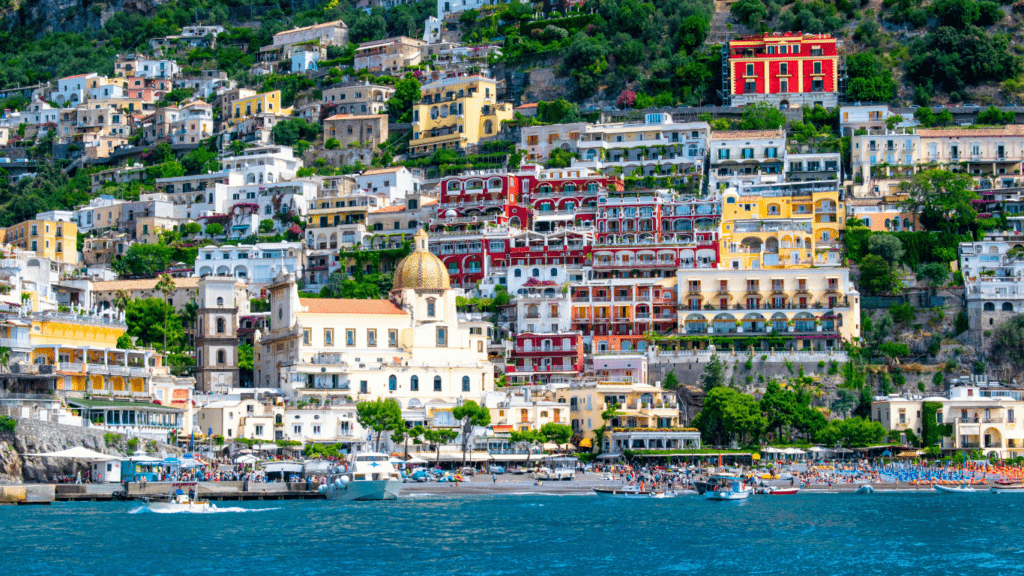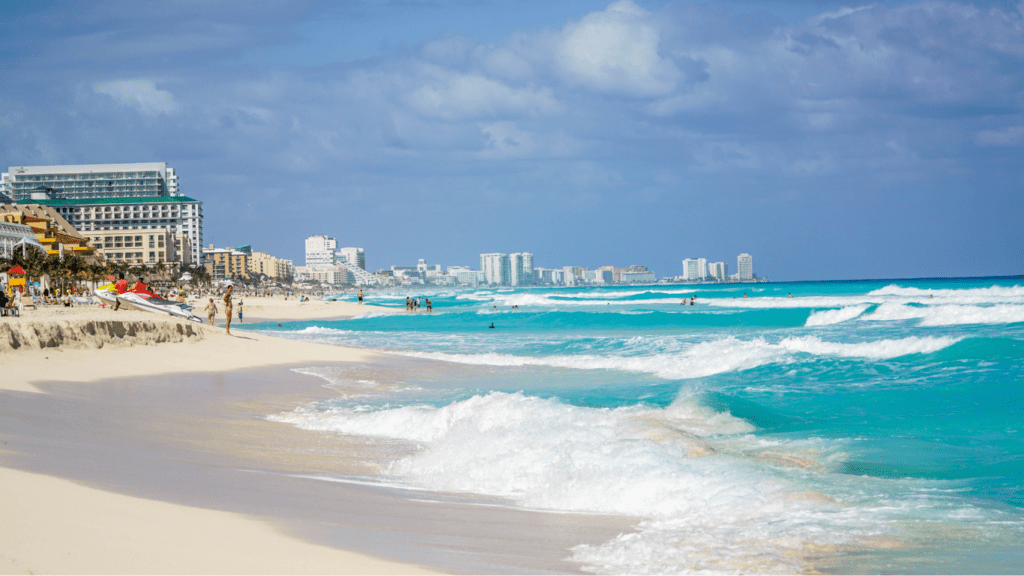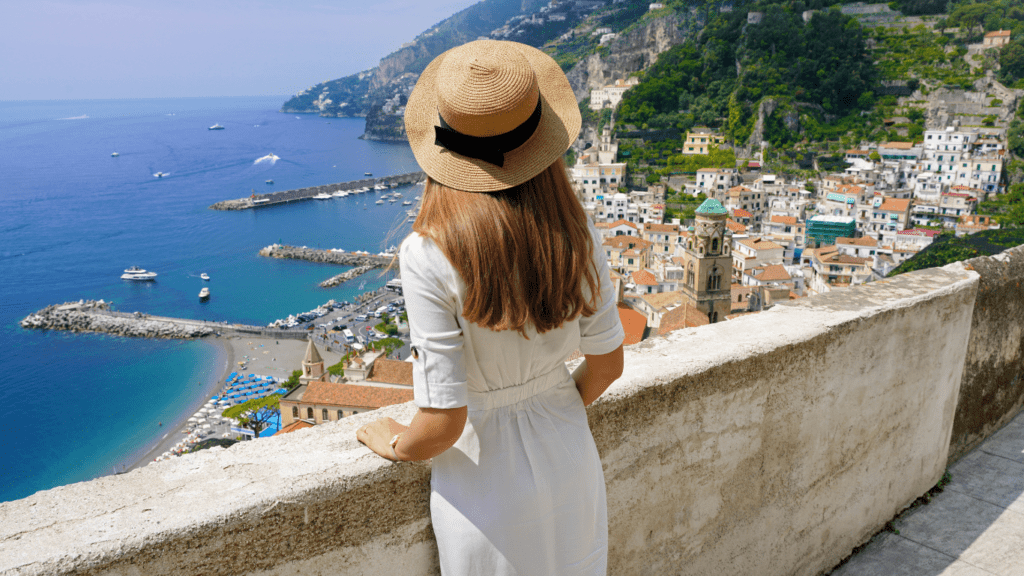Overview of Positano
Positano, nestled on Italy’s Amalfi Coast, boasts stunning vistas that captivate visitors upon arrival. The village’s charm lies in its cliffside location, with houses cascading down to the shoreline. This unique layout offers breathtaking views at every turn.
Since ancient times, Positano has been a significant coastal settlement. Roman ruins, such as the Villa Romana, highlight its historical importance. Every corner of this village whispers stories of its past.
Visitors can explore the Church of Santa Maria Assunta, renowned for its majolica-tiled dome. This historic church holds a Byzantine icon of the Black Madonna, adding to Positano’s cultural richness. Walking through the narrow streets, I notice each turn reveals more of the village’s historical layers.
The village’s climate contributes to its allure. With mild winters and warm summers, Positano offers ideal conditions for year-round visits. While walking along its beaches or exploring its streets, I find the weather perfectly complements every activity.
The local economy thrives on tourism, with numerous luxury hotels and restaurants. These establishments provide a mix of authenticity and sophistication, ensuring an unforgettable experience. From beachfront dining to hilltop stays, the choices are as varied as they are impressive.
Lastly, the village’s connection with artists and celebrities adds to its allure. Many have found inspiration in its beauty, leaving their mark on Positano’s cultural fabric. This glamorous hideaway continues to attract those seeking both escape and engagement. The picturesque landscape, coupled with a rich history and luxurious offerings, makes Positano a must-visit destination.
History and Culture
Positano brims with rich history and diverse culture. Founded by the ancient Romans, this village offers a glimpse into its past through well-preserved ruins. For example, the opulent Villa Romana showcases Roman architectural excellence. Visitors often marvel at its intricate mosaics, which have withstood the test of time.
The Church of Santa Maria Assunta stands as a testament to Positano’s cultural heritage. This iconic church features a Byzantine-influenced dome and the famed icon of the Black Madonna. Locals celebrate the Feast of the Assumption on August 15, drawing tourists eager to participate in the vibrant cultural festivities.
Art has always been integral to Positano’s allure. In the mid-20th century, artists like Pablo Picasso and Paul Klee frequented the village, drawn by its picturesque landscape. Their influence remains evident today, with local galleries displaying a mix of contemporary and classical works.
Positano’s culture also encompasses its culinary traditions. Fresh seafood, homemade pasta, and locally-produced limoncello are staples in the village’s cuisine. Many restaurants offer cooking classes, allowing visitors to immerse themselves in these culinary practices.
Festivals enliven Positano’s cultural calendar. The Luminaria di San Domenico, held in August, illuminates the village with thousands of candles, creating a magical atmosphere. Music lovers flock to the Positano Festival in the summer to experience an array of performances set against the stunning backdrop of the Amalfi Coast.
Family traditions and legends weave themselves into the fabric of Positano. Stories of Saracen pirates and local fishermen permeate local folklore, shared through oral histories and community events.
Positano’s history and culture are as enchanting as its landscape. From Roman relics to vibrant festivals, the village pulsates with stories and traditions that captivate every visitor.
Attractions in Positano

Positano offers a blend of history, art, and nature, making it a captivating destination. Here are some key attractions to explore.
Beaches
Positano’s beaches are renowned for their beauty. Spiaggia Grande is the most famous beach, known for its lively atmosphere and magnificent views. It’s perfect for sunbathing and swimming. For a more secluded experience, Fornillo Beach offers a quieter setting. Arienzo Beach, accessible via a long staircase, is another gem that rewards visitors with its crystal-clear waters.
Historic Sites
Positano’s historic sites reveal its rich past. The Church of Santa Maria Assunta, with its iconic dome, houses the revered Black Madonna. Visitors can explore the ancient Roman frescoes of the Villa Romana, providing a glimpse into the town’s historic grandeur. The Path of the Gods trail offers both historical insight and stunning vistas, tracing ancient routes above the Amalfi Coast.
Art and Museums
Positano’s artistic heritage is showcased in its museums and galleries. The Franco Senesi Fine Art Gallery exhibits contemporary pieces by local and international artists. The Roman Archaeological Museum (MAR) features artifacts from the ancient Roman villa buried by Vesuvius’s eruption. Visitors can also find unique ceramics and sculptures in quaint shops throughout the village.
Dining and Cuisine
Exploring Positano’s dining scene unveils a blend of traditional flavors and modern culinary delights.
Traditional Dishes
Positano’s cuisine features fresh, local ingredients. Seafood dominates many menus, with dishes like “Spaghetti alle Vongole” (spaghetti with clams) and “Scialatielli ai Frutti di Mare” (homemade pasta with seafood) taking center stage. Lemons from the Amalfi Coast inspire dishes like “Risotto al Limone” (lemon risotto) providing a unique citrus twist. Desserts often include “Delizie al Limone” (lemon sponge cakes) and “Sfogliatella,” a flaky pastry filled with ricotta cheese and lemon zest, showcasing the region’s zest for sweet flavors.
Popular Restaurants
Positano offers a range of dining spots. “La Sponda” at Le Sirenuse Hotel provides a fine dining experience with a stunning view of the coastline, ideal for a romantic evening. “Chez Black,” known for its seafood and historic presence, serves delectable dishes with a backdrop of the picturesque marina. For a more casual setting, “Da Vincenzo” offers traditional Italian fare, delivering authentic flavors and a cozy atmosphere. These restaurants exemplify the culinary diversity and excellence in Positano, catering to various tastes and preferences.
Accommodation Options
Positano offers a range of accommodation options to suit every traveler’s budget, from luxury hotels to affordable stays. Each option provides a unique experience of this coastal gem.
Luxury Hotels
Positano’s luxury hotels provide unparalleled comfort and stunning views of the Tyrrhenian Sea. “Le Sirenuse,” for instance, combines elegance with top-notch amenities. Its rooms boast private terraces, and the hotel features a Michelin-starred restaurant. “Il San Pietro di Positano” offers the exclusivity of a private beach and a world-class spa. Each room has a sea view, and guests enjoy private boat tours along the Amalfi Coast. Another standout is “Hotel Poseidon,” which offers spacious rooms, a rooftop pool, and easy access to Positano’s main attractions.
Budget-Friendly Stays
- For those seeking affordable options, Positano has a variety of budget-friendly stays without compromising charm.
- “Hotel Savoia” provides comfortable rooms and a complimentary breakfast, with rates that won’t break the bank.
- “La Rosa dei Venti” features rooms with private balconies overlooking the sea and offers a more intimate experience.
- “Pensione Maria Luisa” presents an excellent choice with its cozy atmosphere and affordable rates.
This family-run hotel offers personalized service and stunning views from its hilltop location. Each option allows visitors to immerse themselves in Positano’s vibrant culture and breathtaking scenery, regardless of budget.
Getting Around Positano
Navigating Positano combines charm and challenge due to its unique landscape. The village’s steep, narrow streets offer limited access, encouraging exploration on foot. Walking is the primary mode of transportation in Positano, with countless steps and pathways unveiling stunning views at every turn.
Walking
Walking is essential for getting around Positano. The village’s stairs, winding streets, and pedestrian-friendly zones make walking the best way to absorb the authentic atmosphere. Comfortable shoes are a must, given the village’s hilly terrain.
Public Buses
Public buses provide an alternative for navigating Positano. Flavio Gioia operates the local bus service, connecting key spots within the village. Buses run on a loop, making it easy to travel between Positano’s upper and lower areas.
Taxis
Taxis offer convenience but are limited due to narrow streets. They are best for short trips and when carrying heavy luggage. Taxis can be hailed at designated taxi stands or booked in advance through local taxi companies.
Ferries and Boats
Ferries and boats provide a scenic way to travel along the coastline. The Positano ferry terminal connects to nearby destinations like:
- Amalfi
- Capri
- Sorrento
Private boat rentals offer personalized excursions and stunning coastal views.
Scooters
Scooters offer a flexible option for getting around. Rental services are available in the village, providing an easy way to navigate the narrow, winding roads. Riding a scooter requires caution, given the area’s steep inclines and sharp turns.
Car Rentals
Car rentals are less practical due to limited parking and narrow roads. Cars are best for trips beyond Positano to explore the wider Amalfi Coast. Major rental companies operate in nearby towns for those planning extended journeys.
Best Time to Visit
Positano offers unique experiences year-round. The ideal time for a visit depends on what one seeks. Spring and fall months, from April to June and September to October, provide mild weather, fewer tourists, and top conditions for exploring. Daytime temperatures usually range between 59°F (15°C) and 77°F (25°C).
Summer, from July to August, sees peak tourist activity. Temperatures can soar up to 86°F (30°C), and the town becomes bustling. Many choose this period for its vibrant beach scene and numerous events.
Winter, from November to March, quieter streets and cooler temperatures, typically between 41°F (5°C) and 59°F (15°C). It’s perfect for those preferring a relaxed ambiance. Note that some businesses and hotels may close during this period.
Choosing the best time to visit Positano hinges on desired activities and crowd preferences. Each season adds a distinct charm to this glamorous hideaway.



 Beauty Product & Fashion Brand Reviewer
Elizabethie Vallestiera is Glam World Walk's go-to expert for in-depth beauty product reviews and luxury brand spotlights. With a meticulous approach to analyzing the latest beauty innovations, she ensures that readers are always informed about the best products on the market. Elizabethie’s passion for uncovering the stories behind iconic fashion brands makes her articles not only informative but also captivating, offering a blend of style, substance, and glamour that readers crave.
Beauty Product & Fashion Brand Reviewer
Elizabethie Vallestiera is Glam World Walk's go-to expert for in-depth beauty product reviews and luxury brand spotlights. With a meticulous approach to analyzing the latest beauty innovations, she ensures that readers are always informed about the best products on the market. Elizabethie’s passion for uncovering the stories behind iconic fashion brands makes her articles not only informative but also captivating, offering a blend of style, substance, and glamour that readers crave.
